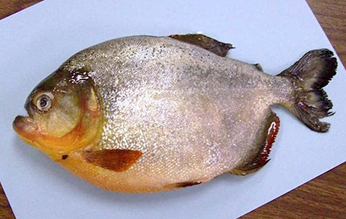(Family Characidae)
General Description
 Red-bellied piranha (Pygocentrus nattereri). Photo courtesy of Florida Fish and Wildlife Conservation Commission.
Red-bellied piranha (Pygocentrus nattereri). Photo courtesy of Florida Fish and Wildlife Conservation Commission.
Piranhas are freshwater, tropical fishes belonging to the family Characidae, which also includes pacus and tetras. Piranhas have deep, laterally compressed bodies. They vary in color by location, population, and age, but many are silvery-gray or golden and some have bright colors such as red or orange on their head, belly, or fins. Piranhas have short, powerful jaws, and lower jaws that protrude beyond their upper jaws. Both jaws are lined with sharp triangular teeth, which allow piranhas to bite into and tear the flesh of their prey. Piranhas commonly grow to 12 inches in length and weigh less than two pounds, but have been reported to grow up to 16 inches and over 7 pounds.
Current Distribution
Piranhas are not currently found in California or elsewhere in the United States. One piranha was captured in a pond in Riverside County, California in 1987; the pond was subsequently drained and no additional piranhas were found. Two piranhas were reported and one collected in a park pond in Santa Barbara County, California in 1989, however experts suggest that these fish may have actually been pacu. In 1998, a single red-bellied piranha was collected from a Simi Valley Golf Course lake in Ventura County, California. Piranhas have been reported or collected in several states across the U.S. and in Lake Ontario, Canada, but no successful populations have established. Piranhas have been eradicated in Florida waterbodies on three occasions in 1962, 1977, and 2009.
Habitat Preference
Piranhas are native to the central and southern river systems of South America, where they inhabit tropical rivers and streams and are often found in murky water. When collected in the United States they have been found in ponds, lakes, rivers, and borrow pits. Piranhas can survive in water temperatures as low as 50°F, and likely establish in waters as low as 57°F. Studies suggest piranhas may be able to overwinter and persist in the waters of southern California, if introduced, as water temperatures in the region are comparable to conditions found in the southernmost areas of their native range.
Pathways
Piranhas are popular aquarium fish; the most common species in the pet trade is the red-bellied piranha (Pygocentrus nattereri). Release by aquarium owners is the most likely pathway for the introduction of pet piranhas into the wild. All species of piranha are on California’s list of restricted animals and cannot be imported, transported, or possessed without a permit.
Impacts
Piranhas are aggressive predators that lurk in vegetation and ambush and chase prey. Their diet consists mostly of insects, mollusks, crustaceans, worms, small fish, and some plant matter, but they often feed in large groups to kill larger prey like capybaras. Piranhas have few predators in the wild except man. If introduced outside of their native range, piranhas would not only prey on native species, but compete with them for food and habitat as well, which could lead to a reduction in the abundance and diversity of native species. California native fish and amphibian populations would be especially at risk if piranha were to ever become established in the state. Piranhas are rumored to have a reputation for attacking humans, but experts believe this may be an exaggeration and suggest that piranhas pose little threat to humans.
Actions Taken if Found
If this species is found in California, do not release it. Preserve (freeze) the specimen and immediately contact the CDFW Invasive Species Program, or email us at Invasives@wildlife.ca.gov, or (866) 440-9530.